
In the 30th Olympiad in London of 2012, along with the constant victory of Chinese athletes, the majestic and exciting national anthem of China was frequently played in award ceremony, which aroused an upsurge of emotion in Chinese compatriots both at home and abroad and moved them to tears. The composer of this national anthem is named Nie Er, and this year is also the 100th anniversary of his birth. In Yuxi City Yunnan Province in July, Yunnan Provincial government and Yuxi Municipal government sponsored a large-scale serial cultural event in commemoration of the 100th anniversary of Nie Er’s birth, which included two concerts, a seminar, a large-scale picture exhibition and the publication of a commemorative book titled Nie Er in a Century. In his immortal melody, people gathered to cherish the memory of this great People’s musician and a vanguard in New Music Event of China.
Nie Er was born in Kunming City, Yunnan Province on February 15, 1912 and his ancestral hometown is Yuxi City. In his short 23 years, he composed many epochal songs in reflection of people’s hardship and Anti-Japanese war at his time, all of which had profound influence and extensive popularity in the whole nation. At Yuxi, you will feel local people’s love and pride for this marvelous composer.
Famous composer Ren Guang was the first person who brought March of the Volunteers abroad. In 1938, he organized Overseas Chinese Song Ensemble in Paris to collect donations in support of Chinese people’s Anti-Japanese War. Moreover, this ensemble participated in the World Anti-Fascism-Invasion Assembly with other 41 countries and presented this anthem. Their high spirits and exciting singing shook the whole world and gained supports from foreigners and overseas compatriots in the world.
The famous American African singer Paul Robeson was the first foreigner that had sung this song in the public. In 1940, a patriot overseas Chinese Liu Liangmo organized a youth song ensemble among American Chinese when he met with Paul Robeson and sang many Chinese songs to the singer. However, the anthem became Paul’s favorite song and Liu Liangmo rendered the lyric into English. From them on, this song was invariably on the repertoire of Paul Robeson in his tour. After gaining popularity among American audiences, this song was called Rising. Therefore, it also became the title of a series of albums of Chinese Anti-Japanese War songs and traditional Chinese folk songs in cooperation of Overseas Chinese Youth Chorus and Paul Robeson, with an English preface written by Madame Song Qingling herself.
During World WarⅡ, many foreign radio stations regarded this song as national anthem of China and published related albums. In 1941 when the Pacific War broke out, this anthem spread its popularity in Southeast Asia such as Singapore and Malaysia. In Malaysia, in the line “Chinese nation is in the most dangerous time” “Chinese nation” was replaced by “Malaya” in order to inspire its people. In 1944, Delhi Radio in India even presented this song as its beginning music of China programs. In 1945, the State Council of USA included it into Victory Triumph Songs of Alliance Army and the United Nations adopted it as the representative song of China. Albums of March of the Volunteers were issued in USSR, USA, France, Czech and Japan. In the film Dragon Seed based on the novel by the American woman writer Pearl Buck, MGM chose this song as an accompaniment song.
Even in Japan, this Chinese musician was highly respected. On April 15, 1935, Nie Er departed from Shanghai via Japan for Soviet Union where he would further his study of music. Unfortunately, he was drowned when swimming in the beach of Fujisawa City on July 17. In order to show respect, Japanese people started constructing monument to Nie Er from 1949 on and this construction was complete on November 1, 1954. Later on, this monument fell down due to typhoon, and thus another monument with the shape of Chinese character Ear was erected. In 1981, Kunming and Fujisawa became sister cities and in April 1981, a memorial plaza for Nie Er was constructed in Fujisawa City where a bronze relief sculpture of this composer was located. July the 17th is then decided by Fujisawa City as Mourning Day of Nie Er, and annually people from all walks of life will hold condolence in front of the monument.
In the foreword of commemorative publication titled Nie Er in a Century, there is a paragraph worth pondering. “If someone asks me, in modern and contemporary Chinese history or even in the whole history of China, which song inspires, encourages, unites and gathers most Chinese people, has made the most extensive and profound impact on national destiny or bears feeling for generations in our blood, the answer is our national anthem—March of the Volunteers”. Along with the enhanced national power of China and increasing exchange with outside world, we are convinced that Nie Er’s songs will spread all over the world and motivate Chinese people forever to endeavor for great revival of Chinese nation.
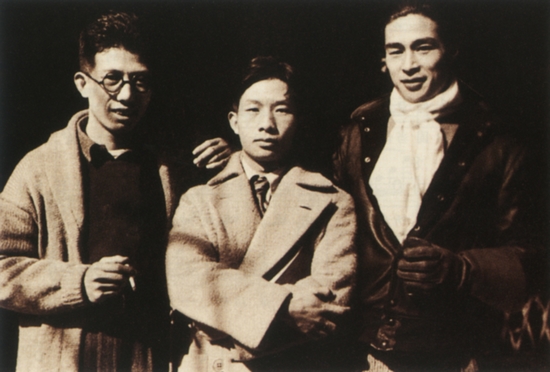
Photo of Nie Er (Middle), Wu Yonggang (Left) and Jin Yan (Right) in winter of 1933
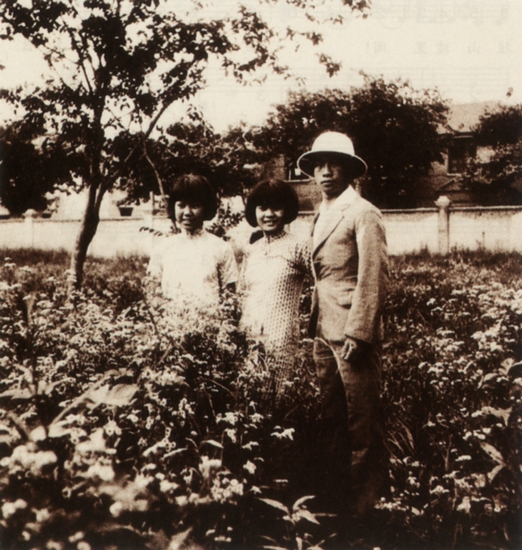
Photo of Nie Er, Bai Hong (Middle) and Li Mingjian, performers of Bright Moon Opera
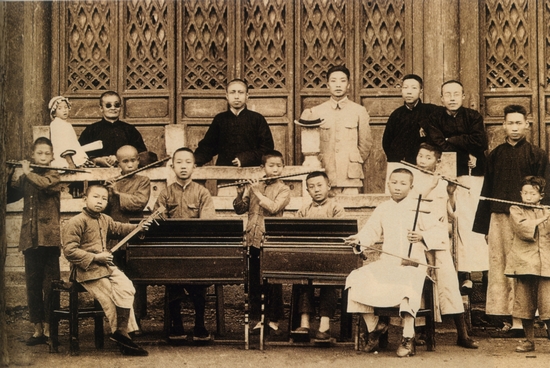
Group Photo of Qiushi Pupil Band and Teacher in 1924, Nie Er was the one who held Three-String Instrument on the Left
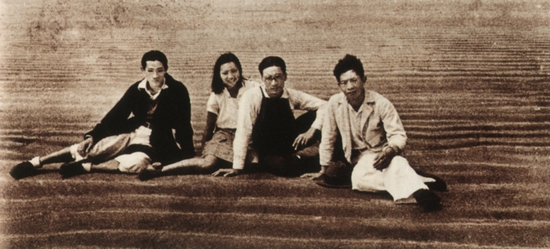
Main Staff of Song of the Fisherman at Beach of Xiangshan County
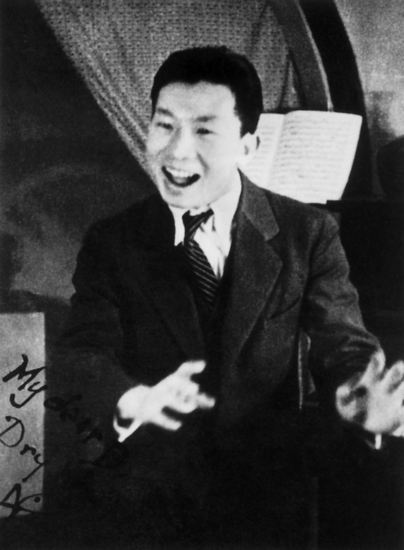
Nie Er in Creation
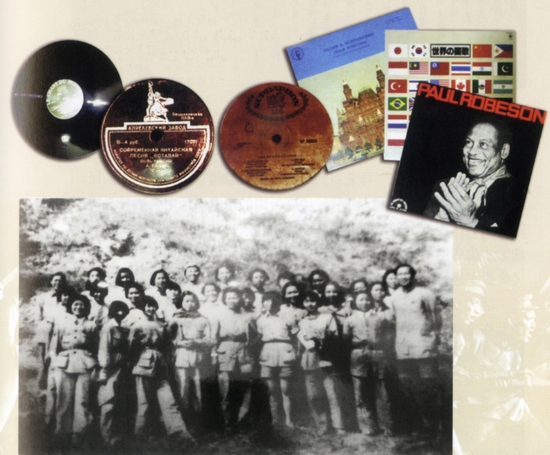
Albums of March of the Volunteers published by USSR, USA,Japan, Czech and France
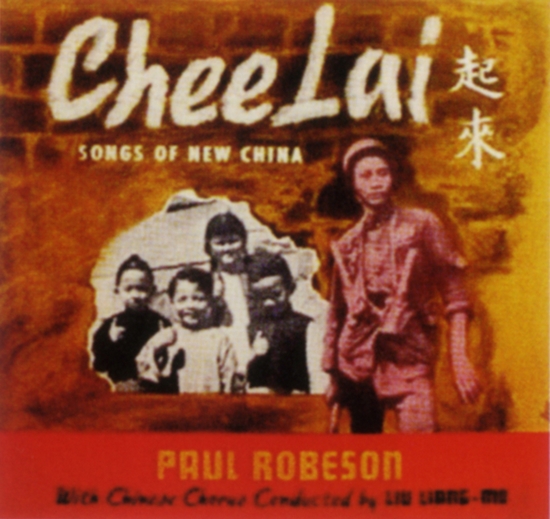
In 1940 March of the Volunteers by Paul Robeson in Chinese was recorded into Album titled Chee Lai. Madame Song Qingling wrote its preface














